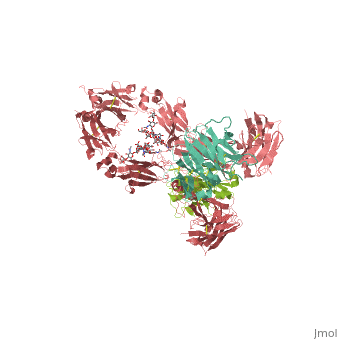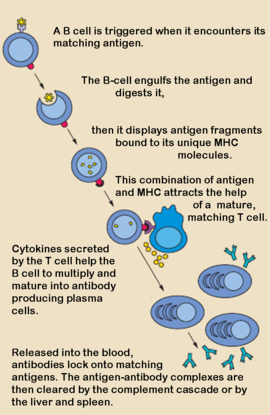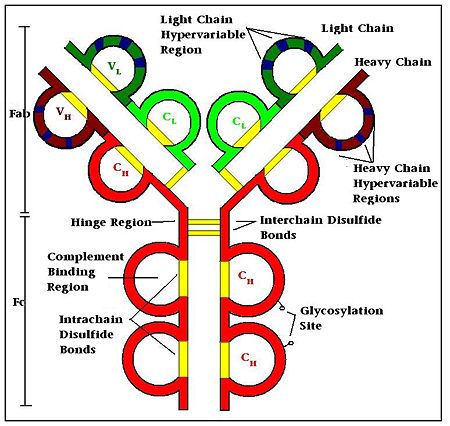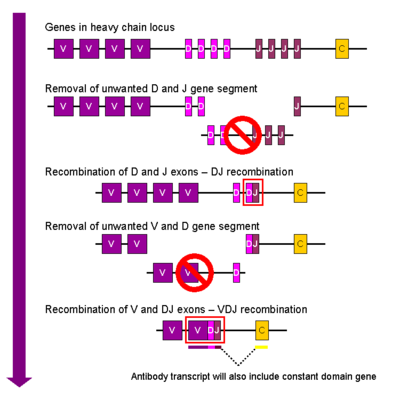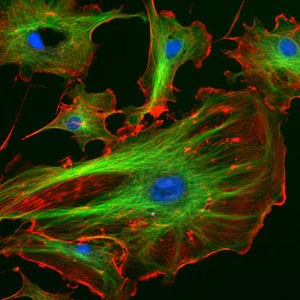Antibody
From Proteopedia
(Difference between revisions)
| Line 6: | Line 6: | ||
[[Image:230px-B cell activation2.png|270px|left|thumb| Production of Antibodies by Plasma Cells]] | [[Image:230px-B cell activation2.png|270px|left|thumb| Production of Antibodies by Plasma Cells]] | ||
{{Clear}} | {{Clear}} | ||
| - | + | __TOC__ | |
==Cellular Basis of Antibody Production== | ==Cellular Basis of Antibody Production== | ||
When a foreign antigen binds to a B-lymphocyte ([http://en.wikipedia.org/wiki/B_cell B-cell]), it activates the B-cell, and upon stimulation by [http://en.wikipedia.org/wiki/Helper_t_cell helper T-cells], undergoes clonal proliferation and B-cell maturation into antibody forming [http://en.wikipedia.org/wiki/Plasma_cells plasma cells]. Each plasma cell is programmed to make an antibody of a single specificity, which it releases into the blood. <ref name="Roit"> Roit, I. M. Roit's Essential Immunology. Oxford: Blackwell Science Ltd., 1997.</ref> Once in the blood, antibodies aid [http://en.wikipedia.org/wiki/Humoral_immune_system the humoral immune system] in three predominant ways: They coat foreign pathogens preventing them from entering healthy cells or disrupting antigen function; they coat pathogens, stimulating their removal via [http://en.wikipedia.org/wiki/Opsonization opsonization] by [http://en.wikipedia.org/wiki/Phagocytes phagocytes]; and they trigger destruction of pathogens by stimulating the [http://en.wikipedia.org/wiki/Complement_system complement pathway] or by [http://en.wikipedia.org/wiki/Antibody-dependent_cellular_cytotoxicity Antibody Dependent Cell-mediated Cytotoxicity], among other immune responses. <ref>PMID:8476565</ref> <ref>PMID:16234578</ref> All of these functions rely heavily on accurate antigen binding and communication with other immune effector cells. The amazing specificity antibodies operate with is made possible by the physical structure of the antibody, which appears simplistic, but contains several levels of additional complexity. | When a foreign antigen binds to a B-lymphocyte ([http://en.wikipedia.org/wiki/B_cell B-cell]), it activates the B-cell, and upon stimulation by [http://en.wikipedia.org/wiki/Helper_t_cell helper T-cells], undergoes clonal proliferation and B-cell maturation into antibody forming [http://en.wikipedia.org/wiki/Plasma_cells plasma cells]. Each plasma cell is programmed to make an antibody of a single specificity, which it releases into the blood. <ref name="Roit"> Roit, I. M. Roit's Essential Immunology. Oxford: Blackwell Science Ltd., 1997.</ref> Once in the blood, antibodies aid [http://en.wikipedia.org/wiki/Humoral_immune_system the humoral immune system] in three predominant ways: They coat foreign pathogens preventing them from entering healthy cells or disrupting antigen function; they coat pathogens, stimulating their removal via [http://en.wikipedia.org/wiki/Opsonization opsonization] by [http://en.wikipedia.org/wiki/Phagocytes phagocytes]; and they trigger destruction of pathogens by stimulating the [http://en.wikipedia.org/wiki/Complement_system complement pathway] or by [http://en.wikipedia.org/wiki/Antibody-dependent_cellular_cytotoxicity Antibody Dependent Cell-mediated Cytotoxicity], among other immune responses. <ref>PMID:8476565</ref> <ref>PMID:16234578</ref> All of these functions rely heavily on accurate antigen binding and communication with other immune effector cells. The amazing specificity antibodies operate with is made possible by the physical structure of the antibody, which appears simplistic, but contains several levels of additional complexity. | ||
Revision as of 10:54, 17 November 2014
| |||||||||||
Contents |
3D Structures of Immunoglobulin
Updated on 17-November-2014
Humanized mouse antibody (hmFab) is a modified mFab which resembles more hFab.
References
- ↑ 1.0 1.1 1.2 1.3 1.4 1.5 1.6 Roit, I. M. Roit's Essential Immunology. Oxford: Blackwell Science Ltd., 1997.
- ↑ Parker DC. T cell-dependent B cell activation. Annu Rev Immunol. 1993;11:331-60. PMID:8476565 doi:http://dx.doi.org/10.1146/annurev.iy.11.040193.001555
- ↑ Rus H, Cudrici C, Niculescu F. The role of the complement system in innate immunity. Immunol Res. 2005;33(2):103-12. PMID:16234578 doi:10.1385/IR:33:2:103
- ↑ Roux KH. Immunoglobulin structure and function as revealed by electron microscopy. Int Arch Allergy Immunol. 1999 Oct;120(2):85-99. PMID:10545762
- ↑ Putnam FW, Liu YS, Low TL. Primary structure of a human IgA1 immunoglobulin. IV. Streptococcal IgA1 protease, digestion, Fab and Fc fragments, and the complete amino acid sequence of the alpha 1 heavy chain. J Biol Chem. 1979 Apr 25;254(8):2865-74. PMID:107164
- ↑ Woof JM, Burton DR. Human antibody-Fc receptor interactions illuminated by crystal structures. Nat Rev Immunol. 2004 Feb;4(2):89-99. PMID:15040582 doi:10.1038/nri1266
- ↑ Putnam FW, Liu YS, Low TL. Primary structure of a human IgA1 immunoglobulin. IV. Streptococcal IgA1 protease, digestion, Fab and Fc fragments, and the complete amino acid sequence of the alpha 1 heavy chain. J Biol Chem. 1979 Apr 25;254(8):2865-74. PMID:107164
- ↑ Harris LJ, Larson SB, Hasel KW, McPherson A. Refined structure of an intact IgG2a monoclonal antibody. Biochemistry. 1997 Feb 18;36(7):1581-97. PMID:9048542 doi:http://dx.doi.org/10.1021/bi962514+
- ↑ Hochman J, Inbar D, Givol D. An active antibody fragment (Fv) composed of the variable portions of heavy and light chains. Biochemistry. 1973 Mar 13;12(6):1130-5. PMID:4569769
- ↑ Putnam FW, Liu YS, Low TL. Primary structure of a human IgA1 immunoglobulin. IV. Streptococcal IgA1 protease, digestion, Fab and Fc fragments, and the complete amino acid sequence of the alpha 1 heavy chain. J Biol Chem. 1979 Apr 25;254(8):2865-74. PMID:107164
- ↑ Woof JM, Burton DR. Human antibody-Fc receptor interactions illuminated by crystal structures. Nat Rev Immunol. 2004 Feb;4(2):89-99. PMID:15040582 doi:10.1038/nri1266
- ↑ Wright A, Morrison SL. Effect of glycosylation on antibody function: implications for genetic engineering. Trends Biotechnol. 1997 Jan;15(1):26-32. PMID:9032990 doi:10.1016/S0167-7799(96)10062-7
- ↑ Heyman B. Complement and Fc-receptors in regulation of the antibody response. Immunol Lett. 1996 Dec;54(2-3):195-9. PMID:9052877
- ↑ Ravetch JV, Bolland S. IgG Fc receptors. Annu Rev Immunol. 2001;19:275-90. PMID:11244038 doi:19/1/275
- ↑ Fanning LJ, Connor AM, Wu GE. Development of the immunoglobulin repertoire. Clin Immunol Immunopathol. 1996 Apr;79(1):1-14. PMID:8612345
- ↑ Diaz M, Casali P. Somatic immunoglobulin hypermutation. Curr Opin Immunol. 2002 Apr;14(2):235-40. PMID:11869898
- ↑ Borghesi L, Milcarek C. From B cell to plasma cell: regulation of V(D)J recombination and antibody secretion. Immunol Res. 2006;36(1-3):27-32. PMID:17337763 doi:10.1385/IR:36:1:27
- ↑ Durandy A. Activation-induced cytidine deaminase: a dual role in class-switch recombination and somatic hypermutation. Eur J Immunol. 2003 Aug;33(8):2069-73. PMID:12884279 doi:10.1002/eji.200324133
- ↑ CHOWN B, LEWIS M, KAITA K. A new Kell blood-group phenotype. Nature. 1957 Oct 5;180(4588):711. PMID:13477267
- ↑ Burnette WN. "Western blotting": electrophoretic transfer of proteins from sodium dodecyl sulfate--polyacrylamide gels to unmodified nitrocellulose and radiographic detection with antibody and radioiodinated protein A. Anal Biochem. 1981 Apr;112(2):195-203. PMID:6266278
- ↑ Brehm-Stecher BF, Johnson EA. Single-cell microbiology: tools, technologies, and applications. Microbiol Mol Biol Rev. 2004 Sep;68(3):538-59. PMID:15353569 doi:10.1128/MMBR.68.3.538-559.2004
Additional Pages
See Also
- Variable Lymphocyte Receptors
- Antibody at High school teachers' resources, where you will find tutorials on antibody structure.
- Antibodies at Wikipedia.
Proteopedia Page Contributors and Editors (what is this?)
David Canner, Michal Harel, Alexander Berchansky, Wayne Decatur, Mark Hoelzer, Eric Martz, Jaime Prilusky
